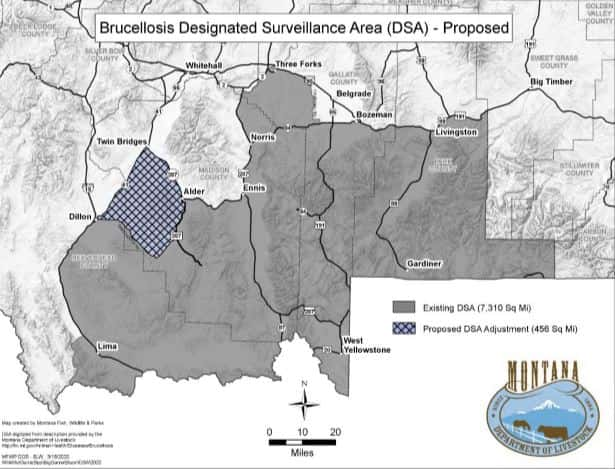Helena, Mont. – The Montana Department of Livestock (DOL) is proposing a change to the boundary of the Designated Surveillance Area (DSA) for brucellosis. The proposed administrative rule change is in response to the discovery of two brucellosis exposed elk in the Ruby Mountains, outside of the current DSA boundary. The boundary adjustment will ensure that cattle and domestic bison at risk of exposure to infected wildlife are included in disease surveillance efforts. A public comment period is open until 5:00 p.m. on June 18, 2020.
Wild elk and Yellowstone National Park bison are the last known reservoirs of brucellosis in the U.S. Periodic transmission from infected wildlife to livestock occurs with infected wild elk determined to have been the source over the last 10 years. The potential for transmission to livestock is why Montana has an established DSA with surveillance and traceability requirements for cattle and domestic bison.
Cattle and domestic bison that utilize ground within the DSA have brucellosis testing, identification, and vaccination requirements. These requirements include brucellosis testing prior to change of ownership or movement out of the DSA. Disease surveillance requirements maintain the marketability of Montana cattle by assuring the brucellosis-free status of Montana livestock.
“This is the fifth boundary adjustment in the 10 years that the DSA has existed,” says Marty Zaluski, State Veterinarian. “Each year, Livestock partners with Fish Wildlife and Parks to conduct live elk captures for brucellosis surveillance. Information from these captures help us determine where and if an expansion to the DSA is necessary in response to the presence of brucellosis positive wildlife on the landscape.”

Since the creation of the DSA, 10 cattle herds have been found with animals infected with brucellosis. Prior to the DSA, if two or more affected herds were detected in a two-year period, the State would lose brucellosis Class Free Status. Due to the current USDA regulations and Montana’s DSA, Montana is not at risk of dropping in Class Status.
“A high rate of testing, much of it voluntary, is the primary reason we continue to find affected herds rapidly, which not only minimizes the impact on that producer but protects our state and our trading partners,” Zaluski added.
Additional information and the proposed rule can be found on the DOL website at www.liv.mt.gov. Comments can be submitted via email to MDOLcomments@mt.gov. Please submit comments no later than close of business on June 18th.
###
Montana Department of Livestock


